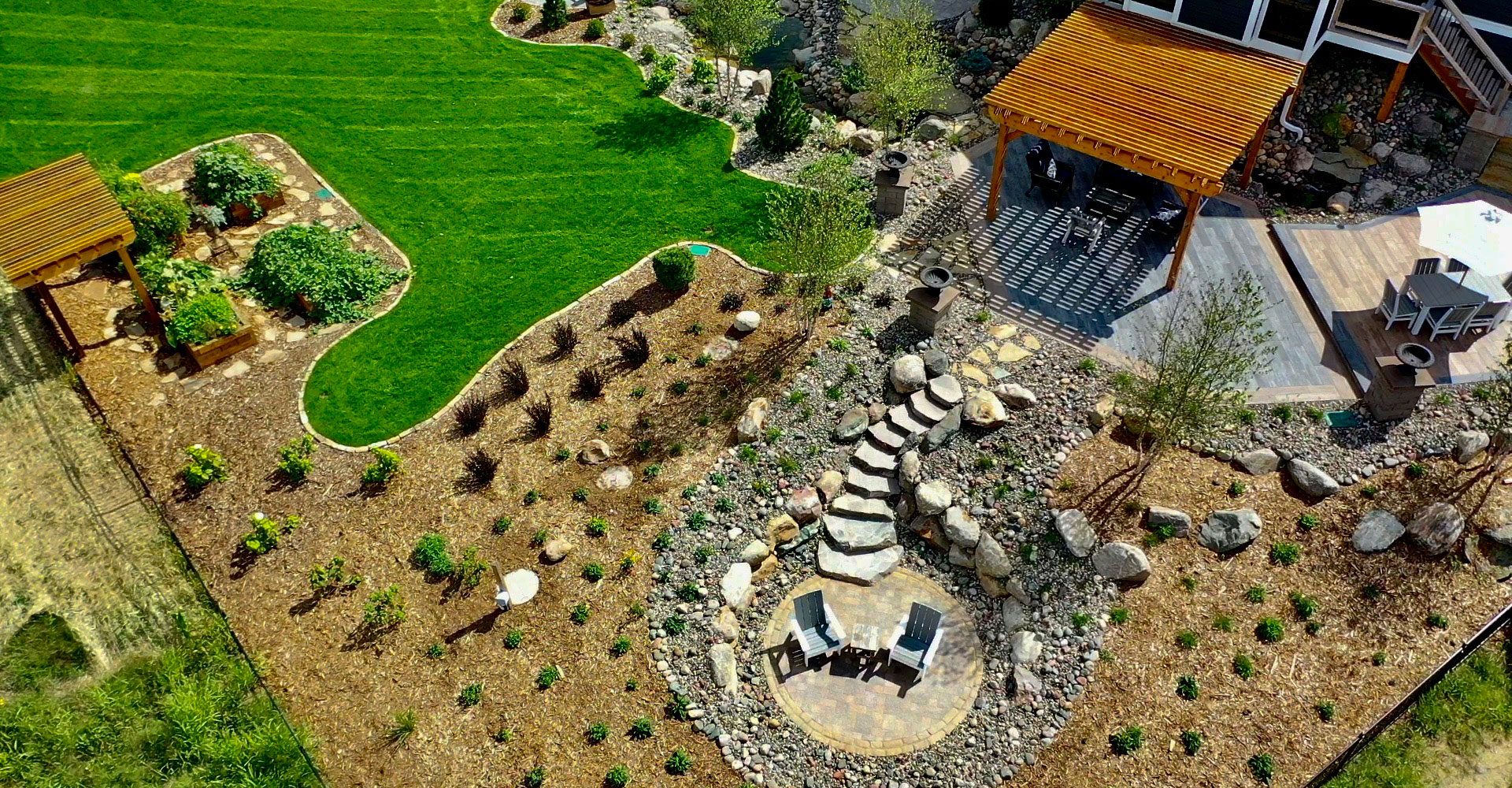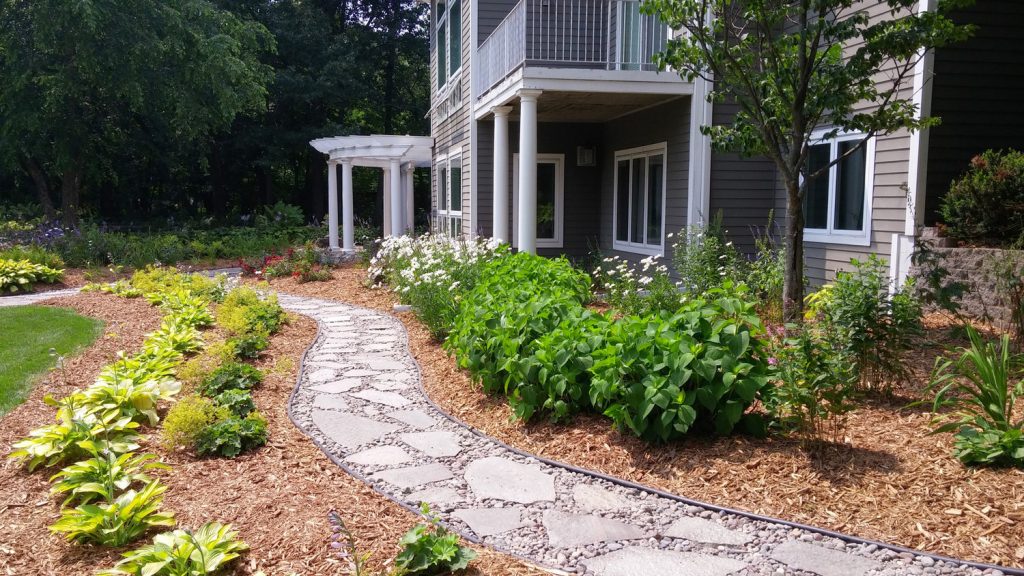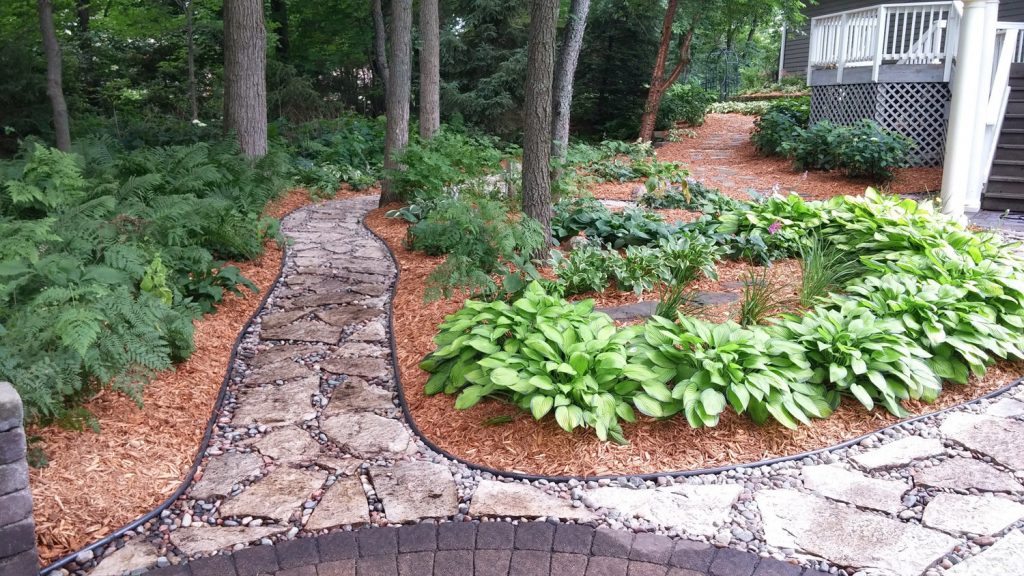
If you are looking for a backyard upgrade, you may be curious about how to make landscaping choices that are more environmentally conscious or wondering how to go about turning your backyard into an eco-friendly oasis. Either way, this article is your guide to eco-friendly landscaping. It will cover the core principles and benefits of sustainable landscaping and show you how to plan, plant, maintain, and sustain your eco-friendly choices.
Eco-friendly landscaping is a method of designing and managing your outdoor spaces that follow eco-friendly choices to reduce environmental harm and enhance biodiversity. These choices extend to your plants and flowers, your hardscape materials, and your maintenance practices.
Eco-friendly landscape choices adhere to three core principles:
The purpose is to create a self-sustaining outdoor space with a balanced ecosystem that does not deplete environmental resources and is harmonious with nature’s inherent rhythms.
Creating a sustainable landscape in your outdoor space also comes with several benefits, including environmental, economic, and social. These benefits include water conservation and pollution reduction. This method of landscaping uses less water to sustain plants than conventional landscapes, but also uses less environmentally harmful chemicals found in synthetic fertilizers and pesticides that contaminate water resources. These chemicals can also add to the cost of your maintenance too. A cost that is absent when you make sustainable choices.
Eco-friendly landscaping usually also requires less time and maintenance since creating a space that is more in harmony with nature also means that nature takes its course in helping your garden thrive. It is the choices you make in designing your eco-conscious backyard that helps you reap these benefits. Let’s dig into what these choices look like.

The first step in your planning for an eco-conscious outdoor space is to assess your site. This includes testing the soil, examining your water drainage system, and looking at the level of sun exposure your space receives. Each of these things will affect what types of plants, trees, shrubs, and flowers you choose for your backyard.
Different types of soil have different qualities when it comes to nutrients as well as water retention and drainage. These qualities create the environment where plants can either thrive or not. Knowing what type of soil is in your yard means you can match it with plants that will thrive in that soil environment. Local nurseries or conservation organizations in your area can help guide you in this process.
In the end, your landscaping plan should align with your values and needs. Taking time to assess what you want to use your backyard for will help direct your choices too. Do you want to create a space to entertain guests, or is having a kid-friendly space ripe for play and discovery more your style? Or maybe you want to create a relaxing outdoor oasis that is a haven for wildlife? Make sure you can fully articulate your landscape vision and purpose before diving into your other choices.
Choosing sustainable plants is a key to eco-conscious gardening since it is an investment in an environment that you completely control and will pay environmental dividends for years to come.
The best sustainable plant choices are those that naturally thrive in your area. You can search for the best native plants for your region with the native plant finder databases from the Audubon Society or the National Wildlife Federation. There are also most likely resources at your local garden centers or native plant societies.
Most popular lawn grasses are not native to most areas and take a lot of time and resources to maintain, including water and chemicals. Making the choice to reduce your lawn size and fill your garden with native ground cover and other landscaping elements such as rocks, pavers, shrubs, native flowers, and creative hardscaping will go a long way in creating your eco-friendly outdoor space.
Choosing plants that support pollinators and wildlife in your area also means choosing native plants that naturally attract these creatures in your region too. By prioritizing a variety of different flowers that bloom at different times during the growing season, you can have pollinators that will visit your garden all season long. Pollinators are attracted to flat, accessible flowers with strong scents and, of course, produce a lot of pollen. You can also make your flowers easily visible to pollinators by planting them in colorful clusters.
Pollinator friendly plants include crocus, tulips, cherry blossoms, zinnias, sunflowers, cosmos, lavender, goldenrod, aster, and coneflower. If you want to attract butterflies to your garden, make sure that you also plant flowers that will also host caterpillars, such as milkweed for the caterpillars of monarch butterflies.
If you live in a drought-prone climate, you will want to make drought-tolerant landscaping choices, this includes low-maintenance plants that thrive under dryer conditions. Some drought-tolerant plants, flowers, and shrubs include lantana, sage, honeysuckle, hawthorn, and cliffrose along with some spruce, boxwood, and sumac. While drought-tolerant groundcover can include sedum, blue fescue, creeping mahonia, dianthus, ice plant, phlox, rosemary, periwinkle, and thyme.
If planting native species is the number one rule of eco-friendly landscaping, then avoiding invasive species is number two. Invasive species are not native to the area that are introduced. They reproduce quickly and spread easily, making them difficult to control and contain. They often kill or choke out other plants and do not add to biodiversity. Instead they harm it by altering the habitat you are striving to create.

Planning your outdoor space to limit your water usage is another important aspect of eco-friendly landscaping. This can be achieved by employing efficient irrigation methods such as drip irrigation, soaker hoses, and rainwater harvesting techniques. You also want to reduce water runoff and erosion, especially in places where rainwater is abundant. Reduction techniques can include installing a rain garden or using permeable pavers.
Another way to reduce water usage is to practice xeriscaping techniques, which include using drought-tolerant plants, grasses, and groundcovers along with designing your landscaping with gravel, rocks, permeable paving walkways, and containers planted with succulents. These techniques are especially important in drought-prone climates where water is most scarce.
Another consideration when creating an environmentally friendly yard is investing in and maintaining your soil health with natural processes, organic fertilizers, and natural pest control.
You can improve your soil naturally through the use of compost, which you can either create yourself through self-composing your organic waste or use a composting resource in your area. Composting adds essential nutrients to your soil through the natural process of breaking down organic material.
Another technique to naturally improve the soil in your yard is through cover cropping, which is essentially planting a fast-growing plant specifically to help restore the soil with nutrients, prevent erosion, and suppress weeds.
Enriching your soil naturally can also be done with organic fertilizers and soil amendments, such as manure, slurry, peat, seaweed, guano, and worm castings. These methods can help improve a soil’s nitrate content and structure, regulate water usage, and improve the health of the soil, which in turn improves the health of what is planted in the soil.
Creating a sustainable garden design is not just about what you plant, but also the hardscaping choices you make, such as patios, walkways, and retaining walls. Sustainable hardscape material choices include recycled materials, such as broken concrete and gravel. You can also incorporate up-cycled materials, such as salvaged bricks or concrete pavers, ceramic tiles, wood planks, or cut stone.
Your hardscaping choices should also contribute to water conservation by reducing storm runoff. Permeable pavers allow rainwater to seep into the soil below the paver, unlike non-permeable pavers where the water can run rapidly over their surface, preventing it from soaking into the soil.
Another important hardscaping consideration for your eco-friendly garden is installing solar-powered lighting.
Green landscaping principles also extend to creating a habitat that will attract birds, butterflies, and beneficial insects to your yard. Planting native plants helps do this, but you can also consider incorporating bird feeders or nesting boxes too. You can also incorporate a water source for wildlife into your design along with areas that provide shelter and habitat for small animals.
As explained earlier, concentrating your plant and flower choices to create a pollinator garden will attract important pollinators into your outdoor space. Most importantly, the more biodiverse your outdoor space is, the more wildlife, including pollinators, birds, butterflies, and beneficial insects will be attracted to it.
Every yard requires maintenance, and your eco-friendly landscape is no different. The goal is to make choices that reduce your maintenance and let nature take some of the maintenance burden. But you will have to do some work to keep your outdoor space thriving and looking beautiful.
Reducing your lawn space will cut down on your need for mowing. You can cut down on your need for weeding by using organic mulch and again, by planting native plants. You can reduce your backyard waste through composting and grass-cycling. And you can cut down on your need for watering with the tips mentioned earlier.
You can practice chemical-free gardening by avoiding synthetic pesticides and herbicides that are harmful to the environment, water resources, wildlife, and beneficial insects. Natural alternatives include neem oil, ladybugs, and lacewings.
Anyone can create an eco-friendly yard by making choices that support sustainability, conservation, and biodiversity. You can start by replacing a small section of your lawn with native plants or investing in more sustainable water choices. Digging into more landscaping ideas to find the right fit for you can be your key to transforming your outdoor space into an eco-friendly landscaping oasis. Imagine a world where every yard is a haven for wildlife and a contributor to a healthier planet. What will your contribution be?
You can contact Tracer Pool and Landscape to get professional advice on upgrading your outdoor space into a sustainable landscape design.